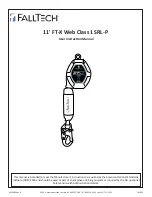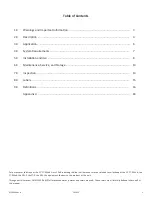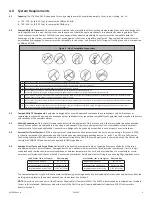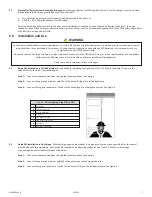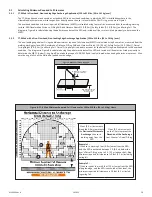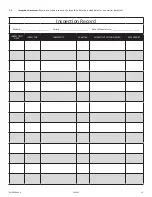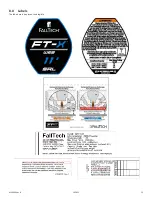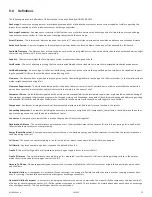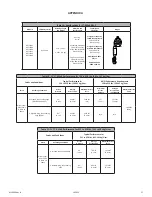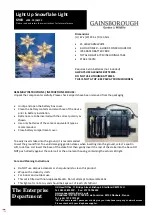
7.0 Inspection
7.1
Pre-Use User Inspection:
Perform an inspection before each use in accordance with the recommendations in Table 1 below.
If an inspection reveals defects or damage to the equipment, remove the equipment from service.
7.2
Inspection Frequency:
Inspection by a competent person at regular intervals is required. The competent person will use the information
in Table 2, SRL Inspection Recommendations, to determine the inspection frequency. Use Table 2 to determine the inspection frequency.
Inspection by a factory authorized inspection entity at regular intervals is also recommended.
Table 2 - ANSI Z359.14-2021 SRL Inspection Recommendations
Type of Use
Application Examples
Conditions of Use
Inspection Frequency
Competent Person
Infrequent to
Light Use
Rescue and Confined
Space, Factory
Maintenance
Good Storage Conditions, Indoor or Infrequent
Outdoor use, Room
Temperature, Clean
Environments
Annually
Moderate to
Heavy Use
Transportation,
Residential
Construction, Utilities,
Warehouse
Fair Storage Conditions, Indoor and extended
outdoor use, All
temperatures, Clean or dusty
environments
Semi-annually to
Annually
Severe to
Continuous Use
Commercial
Construction, Oil and Gas,
Mining
Harsh Storage Conditions, Prolonged or
Continuous outdoor Use, all
temperatures, Dirty
environments
Quarterly to
Semi-annually
7.3
Inspection Checklist:
Use Table 1: Guidelines for SRL Inspection to inspect the SRL.
7.4
Inspection Results:
If an inspection reveals defects in or damage to the equipment, inadequate maintenance, or activated fall indicators,
remove the equipment from service.
102022
MSRD26 Rev B
12
6.0 Maintenance, Service, and Storage
6.1
Maintenance:
Ensure the SRL is kept free of excess paint, grease, dirt or other contaminants as this may cause the lifeline or retracting
mechanism to malfunction. Ensure no debris enters the housing. Clean the exterior of the unit as required with a detergent/water
solution. Do not allow water or other corrosion causing elements to enter the housing. After cleaning, pull the lifeline all the way out,
allow the unit to air dry, then retract the lifeline into the unit. Clean labels as required.
DO NOT
use heat to dry.
DO NOT
attempt to disassemble the SRL.
6.2
Service:
Remove the unit from service if it has been subjected to fall arrest force. Tag the unit as “UNUSABLE” to prevent future use. The
SRD is not repairable.
6.3
Storage:
Store the FT-X Web in a cool, dry, clean environment out of direct sunlight. Position the SRL so excess water can drain out.
Avoid exposure to chemical or caustic vapors. Thoroughly inspect the SRL after any period of extended storage.
Table 1: Guidelines for FT-X Web SRL Inspection
Inspection
Pass
Fail
The web lifeline should extract and retract completely and without faltering and should remain taut under tension without
sagging.
Extract the web lifeline several inches and apply a firm pull to confirm the SRD locks. The locking should be certain and
without skidding. Repeat this lockup at additional places along the lifeline length to confirm the SRD is operating correctly.
Examine the energy absorber on the lifeline to be certain that it has not been activated.
Review the web lifeline closely for wear created by abrasion, tattered yarns, unraveled strands, burns, and cuts. Also examine
for knots, rust, dirt, paint, and grease or oil. Check for damage caused by chemical corruption or excessive heat as evident
with discoloration. Examine for extreme exposure to sunlight and ultraviolet as demonstrated by desiccation.
Check for any missing or loose screws or nuts and any deformed or damaged components.
Examine the external housing for cracks, breaks, or warping.
Review the integral anchor loop and Connector for damage and deformation. The anchor loop should rotate smoothly and be
joined firmly to the housing. The Connector should also rotate smoothly within the anchor loop.
Examine the overall SRD unit for any indications of deterioration or damage.
All labels must be intact and totally readable (see Section 8)

